By Sumaiya Farheen and Andrew Siyabalawatte, April 2023.
Frozen shoulder, also known as adhesive capsulitis, is a condition that causes pain and stiffness in the shoulder joint. It occurs when the capsule of connective tissue that surrounds the shoulder joint becomes inflamed and thickened, which restricts movement and causes pain.
What are the causes of a frozen shoulder?
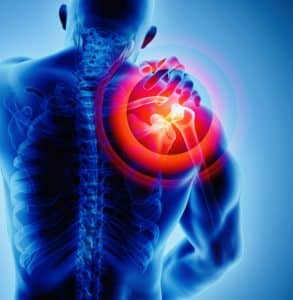
The exact cause of frozen shoulder is not well understood, but there are several factors that may increase the risk of developing the condition.
Age
Frozen shoulder is more common in people over the age of 40.
Gender
Women are more likely than men to develop frozen shoulder.
Certain health conditions
Frozen shoulder is more common in people with diabetes, thyroid disorders, heart disease, or Parkinson’s disease.
Immobilization
Any injury or surgery that immobilizes the shoulder joint, such as a fracture or rotator cuff injury, can increase the risk of developing frozen shoulder.
Repetitive motion
Performing repetitive movements with the shoulder, such as those involved in certain occupations or sports, can increase the risk of developing frozen shoulder.
Genetics
Some people may have a genetic predisposition to developing frozen shoulder.
It’s important to note that in some cases, the cause of frozen shoulder may be unknown.
Symptoms of frozen shoulder in stages
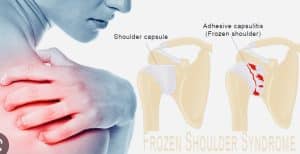
The symptoms of frozen shoulder, also known as adhesive capsulitis, typically develop slowly over time and can be categorised into four stages–
Pre-Freezing
Even though this is the initial stage of frozen shoulder, symptoms may be present for some time, often between 0-3 months. This stage is also known as the inflammatory stage.
Freezing
This is the more active stage of frozen shoulder, where the shoulder gradually becomes painful and stiff. This stage can last anywhere from 3 to 9 months.
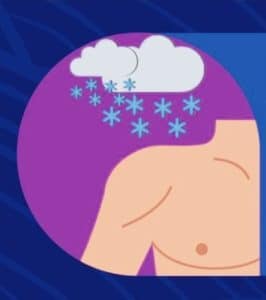
Symptoms
Pain in the shoulder that worsens at night and with movement.
Stiffness in the shoulder joint.
Limited range of motion in the shoulder joint.
Difficulty performing daily activities that involve the use of the affected arm, such as reaching for objects.
Frozen
This stage of frozen shoulder, is often the least painful but the most restrictive. Shoulder movement is hard to come by, particularly the movement of external rotation in the shoulder. By now the body has developed a compensatory mechanism which involves stiffening of the muscles around the spine and shoulder blade, to help assist the restrictive nature of the shoulder.
This stage can last anywhere from 4 to 12 months.
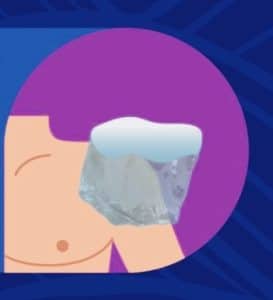
Thawing
This stage is where the shoulder slowly improves with either a complete return to normal or close to normal strength and motion. There is less pain and less restricted mobility.
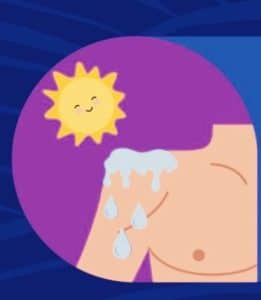
How does Shockwave Therapy help in Frozen shoulder?
Shockwave therapy is a non-invasive treatment that uses high-energy sound waves to stimulate the body’s natural healing processes. This treatment has been used for a variety of musculoskeletal conditions and is clinically proven to help with frozen shoulder.
A clinical study investigated the effectiveness of shockwave therapy for frozen shoulder, and the results were positive. Here are some ways that shockwave therapy may help with frozen shoulder:
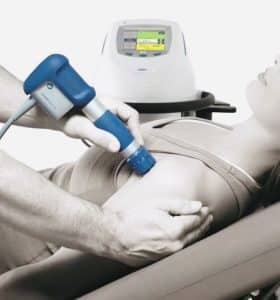
Pain Relief
Shockwave therapy has been shown to reduce pain in patients with frozen shoulder. This is believed to be due to the stimulation of the body’s natural pain-relieving mechanisms and the reduction of inflammation in the affected area.
Improved Shoulder Range of Motion
Frozen shoulder can limit the range of motion in the affected shoulder joint. Shockwave therapy has been shown to improve range of motion in patients with frozen shoulder by reducing the stiffness and adhesions in the shoulder joint.
Accelerated Healing
Shockwave therapy has been shown to stimulate the body’s natural healing processes, leading to faster recovery times in patients with frozen shoulder.
How does an osteopath help you with frozen shoulder?
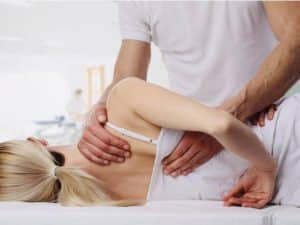
An osteopath can be helpful in treating frozen shoulder by using a holistic approach to address the underlying causes of the condition. Osteopathy is a form of manual therapy that focuses on restoring balance and function to the body’s musculoskeletal system.
In frozen shoulder, the connective tissue surrounding the shoulder joint can become inflamed and thickened, which restricts movement and causes pain. The muscles surrounding the shoulder joint can also become tight and tender due to the limited movement of the joint. Osteopathic treatment can help to release these tight muscles and improve joint mobility.
During an osteopathic treatment for frozen shoulder, the osteopath will evaluate the patient’s posture and movement patterns to determine the root cause of the condition. They may use gentle manual techniques, such as osteopathic manipulative treatment, to help improve joint mobility and reduce inflammation. They may also provide exercises and lifestyle recommendations to help support the healing process and prevent further injury.
Osteopathy can also be helpful in addressing any underlying issues that may be contributing to the frozen shoulder, such as poor posture, imbalanced muscle strength, or other musculoskeletal dysfunctions.
It’s important to note that the severity of frozen shoulder can vary from person to person, and treatment may take some time to achieve significant improvement. In addition, it’s always best to consult with a healthcare professional to determine the best treatment plan for your individual needs.
How does massage help relieve pain for frozen shoulder?
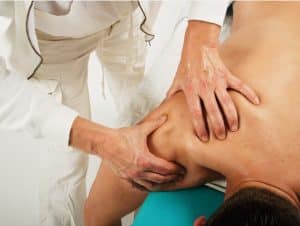
Massage therapy can be helpful in treating frozen shoulder by promoting relaxation, reducing pain, and improving range of motion.
In frozen shoulder, the connective tissue surrounding the shoulder joint can become inflamed and thickened, which restricts movement and causes pain. The muscles surrounding the shoulder joint can also become tight and tender due to the limited movement of the joint. Massage therapy can help to release these tight muscles and promote relaxation, which can reduce pain and improve range of motion.
During a massage therapy session for frozen shoulder, the massage therapist will use specific techniques to target the affected muscles and surrounding tissues. These techniques may include deep tissue massage, myofascial release, and trigger point therapy. The massage therapist may also use gentle stretching to help improve range of motion in the affected joint.
Massage therapy can also help to improve blood flow to the affected area, which can promote healing and reduce inflammation.
Low Level Laser Therapy
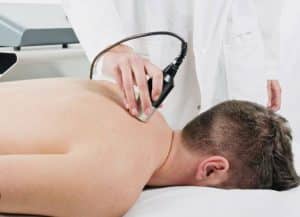
Low level laser therapy (LLLT), also known as cold laser therapy, is a non-invasive treatment that uses low-intensity light to stimulate healing and reduce pain. It can be helpful in treating frozen shoulder by promoting tissue repair, reducing inflammation, and improving range of motion.
In frozen shoulder, the connective tissue surrounding the shoulder joint can become inflamed and thickened, which restricts movement and causes pain. LLLT can help to reduce inflammation and promote tissue repair by stimulating the cells in the affected area with low-level light energy.
During an LLLT treatment for frozen shoulder, the practitioner will apply a low-level laser directly to the affected area. The light energy is absorbed by the cells in the tissue, which stimulates the production of ATP (adenosine triphosphate), the energy source for cellular processes. This increased energy production can help to promote healing and reduce pain.
LLLT can be used in combination with other treatments for frozen shoulder, such as physical therapy or massage therapy.
Dry Needling

Dry needling is a technique that involves inserting thin needles into trigger points, or knots, in the muscles to relieve pain and improve range of motion. It can be helpful in treating frozen shoulder by targeting the tight and painful muscles surrounding the shoulder joint.
In frozen shoulder, the muscles around the shoulder joint can become tight and tender due to the limited movement of the joint. This can cause pain and restrict range of motion. Dry needling can help to release these tight muscles and improve blood flow to the affected area, which can reduce pain and promote healing.
During a dry needling session for frozen shoulder, the practitioner will identify the trigger points in the affected muscles and insert a thin needle into each point. The needle may be manipulated to elicit a twitch response, which is a sign that the muscle is being stimulated and released.
Dry needling can be an effective complement to other treatments for frozen shoulder, such as physical therapy or osteopathic manipulation.
How to sleep with frozen shoulder?
Frozen shoulder can be a painful condition that can make it difficult to sleep comfortably. Here are some tips that may help you sleep better with frozen shoulder-
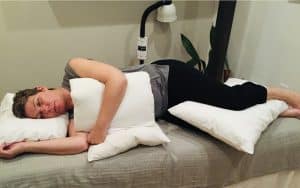
Adjust your sleeping position
Sleeping on the side that is not affected by frozen shoulder may be more comfortable. Use pillows to support your shoulder and help keep it in a comfortable position. You can try placing a pillow under your arm to support your shoulder, or using a pillow between your arm and your body to prevent your arm from resting on your shoulder.
Use heat therapy
Applying heat to the affected area can help relieve pain and stiffness. You can use a hot water bottle, heating pad, or warm towel on your shoulder for 15-20 minutes before bed.
Try gentle stretches
Gentle stretching exercises may help improve range of motion and reduce stiffness. Consult with your doctor or physical therapist before starting any exercise routine.
Practice relaxation techniques
Stress and anxiety can make it difficult to sleep. Practice relaxation techniques such as deep breathing, meditation, or yoga to help you relax and fall asleep easier.
Book a session with us at Back To Health Wellness.

